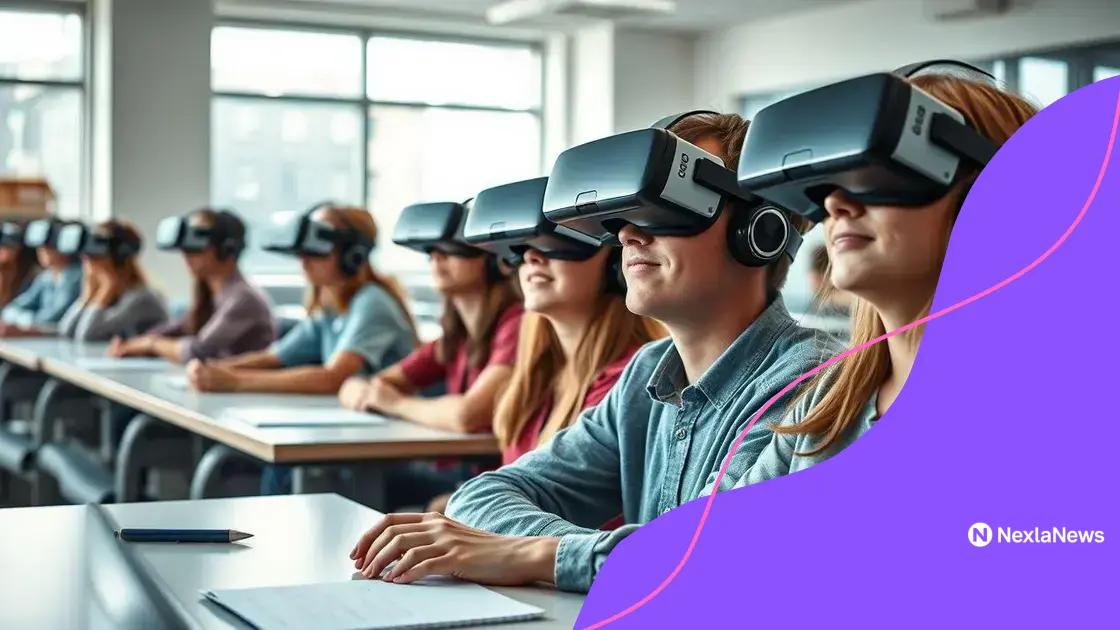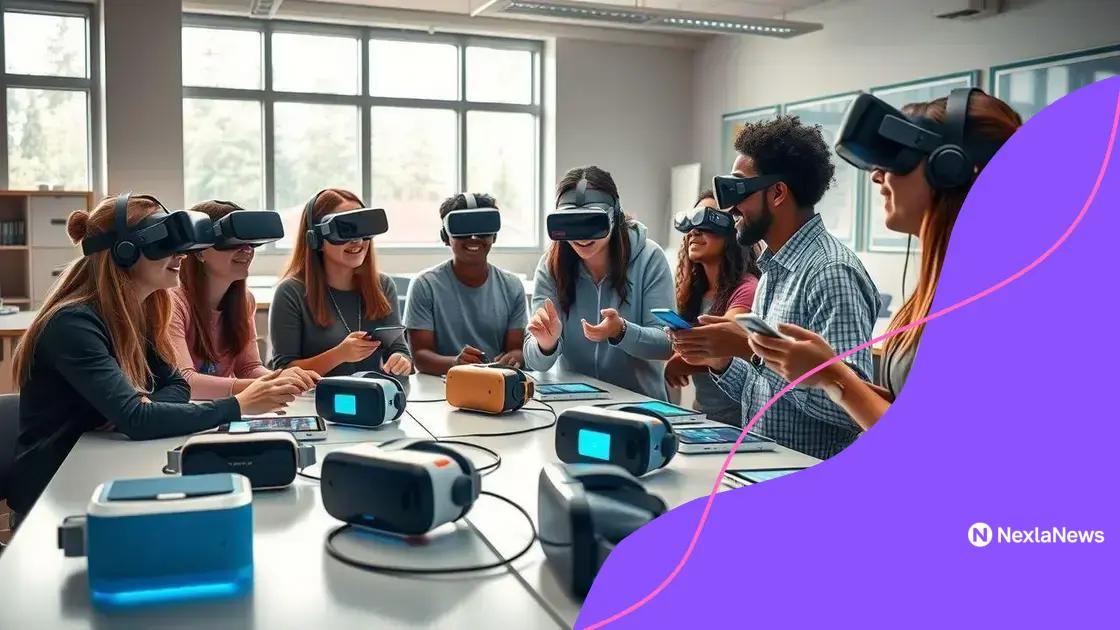Virtual reality tools for learning: transform your education

Virtual reality tools for learning transform education by providing immersive and interactive experiences, enhancing student engagement, and facilitating personalized learning in various subject areas.
Virtual reality tools for learning are changing the landscape of education, providing immersive experiences that captivate students. Imagine stepping into a historical event or exploring the depths of the ocean—all from your classroom. Sounds intriguing, right? This article dives deep into how VR can revolutionize your learning environment.
Understanding virtual reality in education
Understanding virtual reality in education is essential for grasping how this technology can reshape the learning experience. By immersing students in interactive environments, educators can enhance engagement and understanding. Imagine being transported to ancient Egypt to explore its pyramids or diving into the ocean to study marine life—all through a VR headset.
Virtual reality (VR) allows students to learn in ways that traditional methods cannot achieve. This technology provides hands-on experiences that encourage exploration and curiosity.
Benefits of VR in Education
One major advantage of using VR in the classroom is the ability to reach different types of learners. It accommodates visual, auditory, and kinesthetic learners equally well. Additionally, VR can make difficult subjects more accessible and enjoyable.
- Immersive learning experiences
- Increased student engagement
- Enhanced retention of information
- Ability to explore complex concepts
Furthermore, the use of VR can lead to improved collaboration among students. Working together in a shared virtual environment helps build teamwork and communication skills.
Challenges of Implementing VR
Despite the benefits, schools may face challenges when integrating VR technology. Factors such as cost and the need for technical training for teachers are important considerations. However, many educational institutions are finding ways to overcome these obstacles.
- Budget constraints
- Training requirements for teachers
- Access to appropriate hardware
- Content creation needs
To address these challenges, schools can start by introducing basic VR tools and gradually expand their offerings. Collaboration with tech companies for resources can also make the transition smoother.
In conclusion, understanding how virtual reality in education works is crucial for both educators and students. By embracing this technology, the potential for enhanced learning experiences is significant.
Benefits of using VR tools for learning
Benefits of using VR tools for learning can significantly enhance the educational experience for students. These tools create immersive environments where learners can engage with their subjects in unique ways. By stepping into a virtual world, students can see and interact with content that would be difficult to replicate in a traditional classroom.
One of the key advantages of VR is increased engagement. Students often find learning through VR more enjoyable, which keeps their attention focused on the material. When they are actively participating in their education, they are more likely to retain information.
Enhanced Understanding of Complex Concepts
Virtual reality can help students grasp challenging topics. For instance, visualizing abstract mathematical concepts or exploring the human anatomy becomes more tangible with VR. This technology allows for real-time interaction and exploration, leading to deeper comprehension.
- Interactive simulations promote hands-on learning.
- Visual aids help clarify difficult subjects.
- Immediate feedback aids in understanding and skill development.
- Engagement in simulated environments fosters curiosity.
Another benefit is the opportunity for experiential learning. Students can practice skills in a safe setting without the fear of real-world consequences. For example, medical students can perform virtual surgeries, while engineering students can test designs in a controlled digital space.
Catering to Diverse Learning Styles
VR tools are also beneficial because they cater to various types of learners. Whether a student is auditory, visual, or kinesthetic, VR can provide a tailored experience. This level of customization supports different learning preferences, making education more inclusive.
- Visual learners benefit from immersive graphics.
- Auditory learners can engage with narrations within the VR.
- Kinesthetic learners thrive in interactive environments.
- Allows collaboration among students in virtual spaces.
Incorporating VR into education can also promote teamwork. Students collaborating in virtual scenarios learn vital communication and cooperation skills, which are essential in both academia and the workplace.
How to choose the right VR tools

How to choose the right VR tools for education is crucial to maximizing their effectiveness in the classroom. With numerous options available, it can be daunting to find the perfect match for your students’ needs. The right tools can enhance engagement and improve learning outcomes.
When selecting VR tools, consider the educational objectives you want to achieve. Start by identifying the subjects or skills you wish to enhance. For instance, if you aim to improve scientific understanding, look for VR applications that offer interactive simulations of scientific concepts.
Assessing Your Budget
Budget is another important factor in the decision-making process. VR equipment can vary significantly in price. Be sure to evaluate what you can afford while keeping in mind the potential impact on student learning. Here are some budget-friendly ways to integrate VR:
- Utilize mobile VR headsets that are cost-effective.
- Explore free or low-cost VR applications.
- Partner with technology companies for discounts or donations.
- Consider renting equipment for special projects.
Choosing VR tools also requires consideration of compatibility with existing technology in your school. Make sure that the VR tools you select can work seamlessly with your current computers, tablets, or other devices. This will help avoid technical issues during implementation.
Evaluating Content Quality
Quality of content is paramount when selecting VR tools. Look for educational applications that are well-reviewed and align with your curriculum. Choosing high-quality content ensures that students benefit from rich learning experiences.
- Check for positive reviews from other educators.
- Assess if the content is age-appropriate and engaging.
- Look for tools that offer comprehensive learning materials.
- Ensure the content includes interactive elements.
Another important aspect is ease of use. The VR tools should be user-friendly for both teachers and students to navigate. This leads to a smoother experience in the classroom, encouraging more frequent use of the technology.
As technology evolves, keep abreast of new developments in VR for education. Join forums or networks to share experiences and learn from other educators. This can help you stay informed about the latest tools and best practices.
Success stories of VR in classrooms
Success stories of VR in classrooms highlight the transformative impact that virtual reality can have on education. Many schools have embraced VR tools to enhance learning experiences. These stories showcase how immersive technology captivates students and enriches their understanding of various subjects.
In a notable example, a high school in California implemented VR during their biology lessons. Students were able to explore the human body in 3D, viewing organs and systems up close. This interactive experience resulted in a significant increase in test scores and overall engagement with the subject matter.
Enhancing Historical Understanding
Another inspiring case comes from a middle school that utilized VR to teach history. Students were virtually transported to ancient Rome, where they could explore the Colosseum and interact with historical figures. This approach fostered a deeper appreciation for history and sparked lively discussions among students.
- Students reported improved retention of historical facts.
- Group projects involved creating presentations based on their virtual experiences.
- The technology encouraged collaboration and critical thinking.
The use of VR has also revolutionized language learning. In a language immersion program, students used VR to visit foreign countries. They practiced their language skills by engaging with native speakers in realistic settings. This method not only increased their confidence but also improved their conversational abilities.
STEM Education Improvement
Moreover, VR in STEM education has shown remarkable results. A group of students in a robotics class used VR simulations to design and test their projects. By visualizing the mechanics and components, they learned problem-solving skills quickly. This hands-on experience made the concepts much clearer than traditional teaching methods.
- Increased interest in pursuing STEM careers.
- Opportunities for experimentation without risk.
- Enhanced understanding of engineering principles.
- Improved teamwork through collaborative projects.
Another high school adopted VR technology to create a virtual lab for chemistry experiments. Students conducted experiments safely and often with complex reactions they could not otherwise perform in a traditional lab setting. Feedback indicated that students felt more invested in their learning.
These success stories illustrate the potential of VR tools in transforming education. As more schools share their experiences, it is clear that virtual reality is becoming an essential part of modern learning.
The future of virtual reality in education
The future of virtual reality in education looks promising as technology continues to evolve. With advancements in hardware and software, VR is set to become even more accessible and effective in classrooms. This evolution opens up exciting possibilities for both students and educators.
One significant trend is the integration of artificial intelligence with VR. AI can personalize learning experiences based on individual student needs and preferences. Imagine a classroom where every student learns at their own pace in a virtual environment tailored specifically for them.
Increased Accessibility to Education
As VR technology becomes more affordable, schools worldwide can gain access to these tools. This will help bridge educational gaps, providing students from all backgrounds with equal opportunities to learn. Virtual field trips to museums or historical sites will no longer be limited to those who can visit in person.
- Access to global resources will enhance learning.
- Students in remote areas can connect with top educators.
- Greater availability of content in different languages.
- Support for diverse learning needs through customized experiences.
Moreover, collaboration between institutions will increase. Schools can share VR resources and knowledge, creating a more unified approach to education. For example, students from various countries may work on joint VR projects, fostering cultural understanding and teamwork.
Real-World Applications
In the future, we can expect to see more real-world applications for VR in training programs. Industries such as healthcare, engineering, and aviation are already using VR for training purposes. This trend will trickle down to educational institutions, providing students with hands-on practice in their fields.
- Future doctors practicing surgery in virtual environments.
- Engineers testing designs without physical prototypes.
- Aspiring pilots training in realistic flight simulators.
- Enhanced safety and efficiency in vocational training.
Another exciting prospect is the use of VR for social-emotional learning. Virtual reality can create scenarios where students practice communication and empathy in safe environments. This will help cultivate important life skills and emotional intelligence.
As we look ahead, the potential for virtual reality in education is vast. Schools that embrace this technology will not only foster a more engaging learning environment but also prepare students for a future where technology plays an even bigger role in their lives.
FAQ – Frequently Asked Questions about Virtual Reality in Education
How does virtual reality enhance learning in the classroom?
Virtual reality engages students by providing immersive experiences that make learning interactive and enjoyable.
What are the benefits of using VR tools in education?
VR tools promote personalized education, improve accessibility, and offer real-world applications across various fields.
Can VR be used to teach subjects like history and science?
Yes, VR can transport students to historical events or allow them to conduct virtual science experiments, enhancing their understanding.
How can schools afford virtual reality technology?
As technology becomes more affordable, schools can access budget-friendly options like mobile VR headsets and free educational applications.
